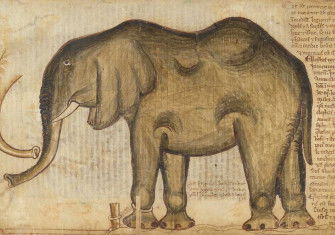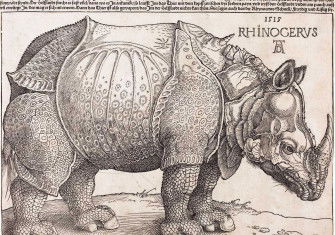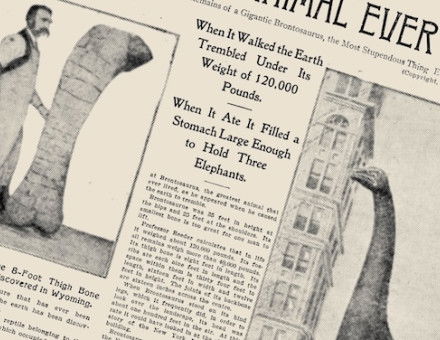Tutankhamun’s Ostriches
Ungainly but fleet of foot, the flightless bird offers insights into the life of a legendary pharaoh.

It was not until several months after the discovery of Tutankhamun’s tomb in 1922 that Howard Carter spotted it. By then, the antechamber had been largely cleared, the burial chamber had been opened and work had already begun on disassembling the huge golden shrines enclosing the sarcophagus. So many extraordinary objects had been found that Carter might easily have missed it. There were funeral beds in the shape of exotic animals, chariots, statues, vases, jewelled necklaces, leopard-skin cloaks and everything from food and mirrors to walking sticks and loincloths. But there, on the ground between the second and third shrines, it lay – the ostrich feather fan.
At first glance it didn’t seem anything out of the ordinary. As Carter noted, it was the sort of fan you could find being wafted at pharaohs in any number of paintings and reliefs. Just over a metre long, it was made of wood and ‘covered with sheet gold’. As was usual in fans of this type, the handle culminated in papyrus and, around the edge, 30 brown and white feathers had once been arranged. What made this fan unusual, however, was that, according to the inscription, the feathers had come from an ostrich killed by Tutankhamun himself. A pair of decorative scenes embossed on the palm commemorate the hunt. On the obverse there is the chase. The pharaoh is in his chariot, drawing his bow to shoot a pair of startled-looking birds while his faithful sloughi hound runs beside the galloping horses. On the reverse, there is the haul. Well pleased with his success, Tutankhamun rides at a leisurely pace, carrying a bunch of wing feathers under his arm and preceded by two attendants carrying the ostriches he has just felled.
Compared to the great funerary mask, or the Anubis shrine, of course, this might seem like nothing more than a curiosity. But of all the finds in Tutankhamun’s tomb, the fan has proved to be among the most revealing.
Truth and justice
In itself, there was nothing particularly unusual about a pharaoh hunting ostriches, or having an ostrich feather fan. Ostriches were relatively common. They appear to have been concentrated mostly in southern Egypt, the kingdom of Kush (Nubia) and Punt, a rather shadowy region, probably extending down to the Horn of Africa. And since the earliest times, ostrich hunting had been a favourite pastime of pharaohs. There is even evidence that some birds may have been raised domestically.
Part of the reason for the ostrich’s fascination was its peculiar nature. The largest flightless bird on earth, it can grow up to 2.8m in height and can run at speeds approaching 70km an hour. While its head and neck are virtually bare, its body is covered in long, shaggy feathers, which hang loosely instead of locking together. It lays the largest eggs of any living animal. If that were not enough, it also has a habit of performing a ‘dance’ at dawn.
All of this seems to have impressed the Egyptians. Its speed made it excellent sport; its feathers made for elegant accessories; its eggs were used to make various decorations, from vases to beads; and at least one pharaoh, Ahmose I, was compared to a ‘dancing ostrich’, because of his devotion to the sun god, Ra.
But it was the ostrich’s religious significance which seems to have cemented its appeal. Though it was not accorded any ‘protective’ functions of its own, as cats were, it was nevertheless cloaked with divine associations. Ostrich feathers were connected with the goddess Ma’at. The child of Ra and Hathor, Ma’at was the goddess of truth, justice and wisdom and regulated the harmony of earthly things. The feather was her distinctive attribute. From the Old Kingdom onwards, she was rarely – if ever – depicted without one tucked into her headband. Indeed, so strong was the identification that ostrich feathers were even used as a symbolic representation of Ma’at and the qualities she embodied.
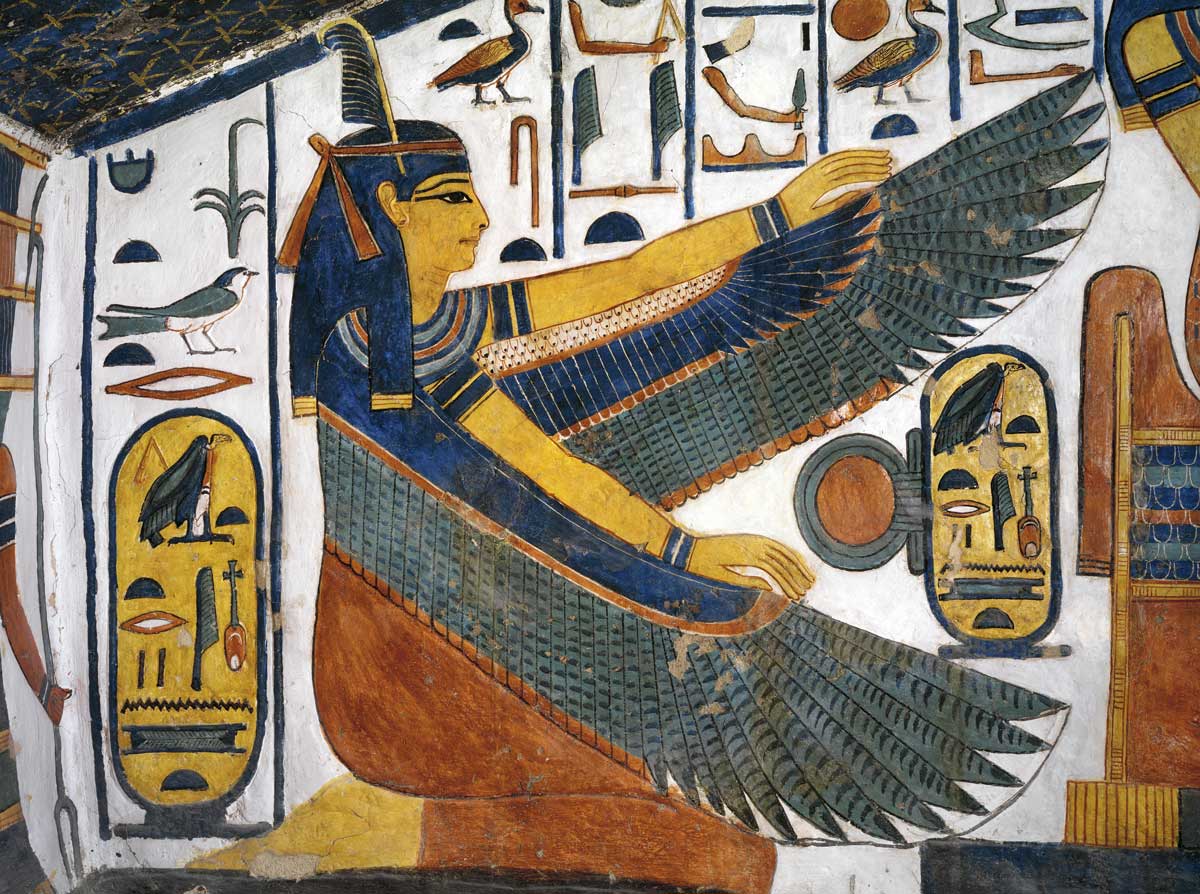
This was most clearly seen in Egyptian beliefs about the afterlife. According to the Book of the Dead, the heart of a deceased person was weighed against a ‘Feather of Ma’at’. If the heart was lighter than the feather, the dead person had led a pure life and was allowed to proceed to a heavenly paradise known as the ‘Field of Reeds’. If, by contrast, the heart was heavier, it was unmistakable proof of wickedness and the deceased would be eaten by the demon Ammit.
Such a strong association with truth and justice thus gave ostriches a cachet beyond anything they might have enjoyed as a result of their natural characteristics. Not only did it make their feathers a visible manifestation of righteousness and hence suited for wear by high-ranking officials and soldiers, but it also made them unusually fitting quarry for pharaohs.
Little known life
That Tutankhamun should have engaged in an ostrich hunt is nevertheless telling.
Despite the richness of his tomb and the wealth of treasures it disgorged, little is known about Tutankhamun. His parentage is unclear. While it is thought that his father was probably Akhenaten (Amenhotep IV), his mother has eluded identification. She may have been Nefertiti, Nefertiti’s daughter Meketaten, or a sister of Akhenaten known as the ‘Younger Lady’. He was born in a period of religious turmoil, during which worship of the traditional gods was replaced with the cult of the sun disc Aten, a fact reflected in his birthname ‘Tutankhaten’ (‘living image of Aten’). After Akhenaten’s death, at least one, perhaps two, pharaohs ruled over Egypt before Tutankhamun assumed the throne at the age of eight or nine. As the so-called ‘restoration stele’ testifies, his reign witnessed the restoration of traditional patterns of worship and the return of the capital from Amarna to Thebes. Other inscriptions indicate that he founded the walled town of Faras and that a war was waged against the Nubians in his name. He married his half-sister Ankhesenamun, they had two stillborn daughters and he died at the age of 18 or 19. Beyond these few facts, however, almost nothing can be said with any certainty.
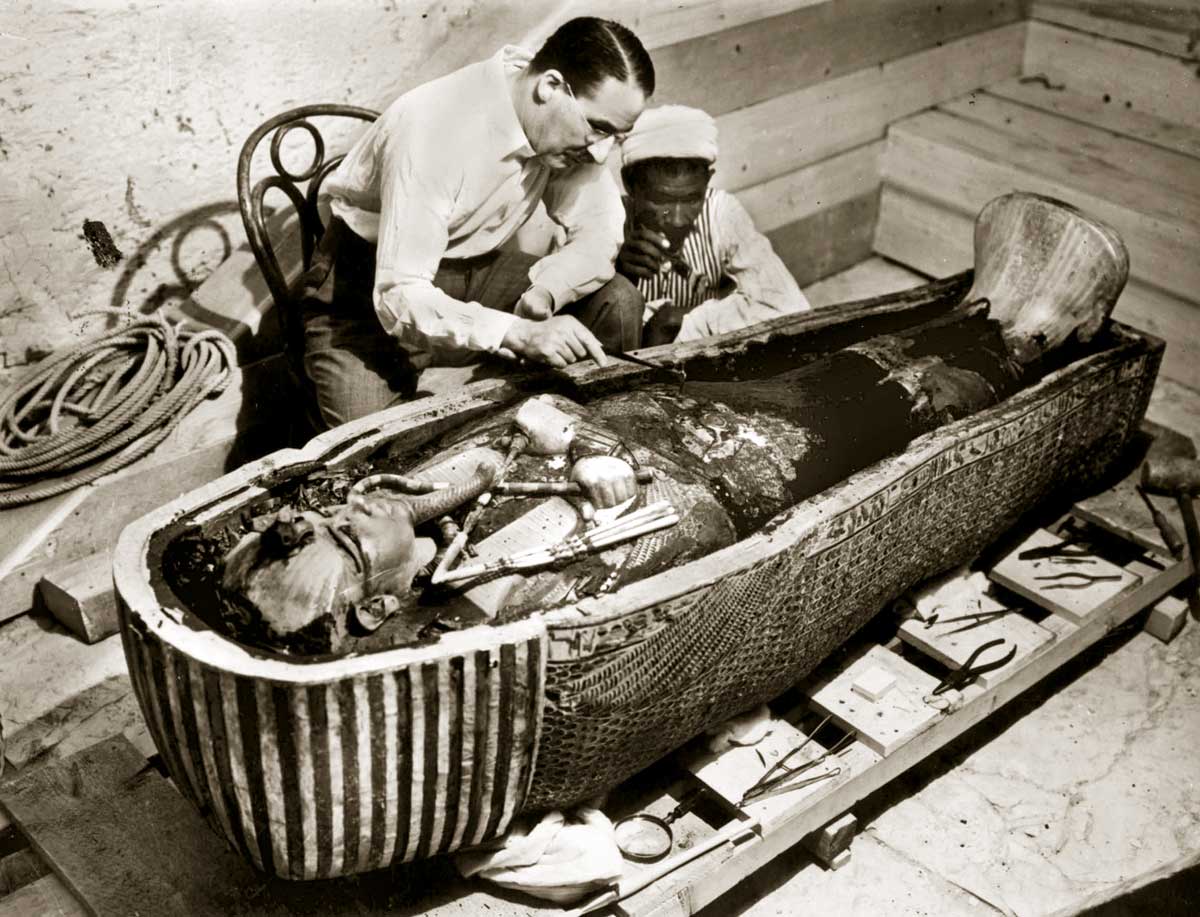
Why he died so young has naturally been an abiding mystery. Over the past century, his mummy has been subjected to a great many autopsies and the results have given rise to even more theories. In the late 1960s it was thought that, because two bone fragments were found inside his skull, he had been murdered. More recently, opinion has tended to favour some sort of congenital disorder or disease. Scoliosis, Marfan syndrome, epilepsy, malaria, craniosyntosis, Antley-Bixler syndrome and a host of others have all been proposed. Some, such as the German geneticist Carsten Pusch, have suggested that Tutankhamun had a club foot and needed a cane to walk; others have argued that he suffered more severe mental impairments. In the absence of any unequivocal evidence, none of these diagnoses is particularly convincing; but the suspicion of physical infirmity has nevertheless had serious implications for how his reign has been viewed. Many scholars have assumed that, if he was disabled or ‘infirm’, then he must have been a ‘weakling’. Coupled with the fact that he was still a teenager when he died, this has fuelled speculation that he was merely a ‘boy king’, who was incapable of dealing with the social and religious turmoil then sweeping Egypt and who was dominated by his vizier Ay and commander-in-chief Horemheb, each of whom succeeded him in turn.
Royal vigour
One of the difficulties of this narrative is that it appears to jar with the emphasis on royal vigour in Tutankhamun’s tomb. As Carter observed, scenes of sporting life ‘constantly confront us’. Hidden away in its sealed chambers were boomerangs, bows ‘richly adorned with semi-precious stones and daggers embossed with images of wild beasts’. The pharaoh’s cosmetic jar bears images of ‘the huntsman’s favourite game’; an ebony casket shows Tutankhamun shooting wildfowl and fish; and on a flake of limestone found near the entrance there is even a sketch of the ‘young king …slaying a lion with a spear’. There are even some images of a more martial nature. One scene from the king’s painted wooden box shows him in his war chariot slaying Nubian soldiers; in another he is seen in the guise of a sphinx, trampling Syrians underfoot.
Needless to say, proponents of the ‘boy king’ hypothesis have claimed that these should not be taken at face value. Bows, boomerangs and daggers, they argue, are less meaningful than they seem. By the beginning of the New Kingdom, the inventory of objects included in royal burials had largely been formalised, with items being chosen more for their use in the next world than for their relevance to the pharaoh’s life in this. Doubts have also been expressed about the utility of images. Given that hunt and battle scenes had become an integral part of pharaonic iconography under the New Kingdom, it has been suggested that they were intended as stylised representations of how a monarch was ‘supposed’ to act, rather than as accurate depictions of lived reality.
But this is what makes the ostrich feather fan so revealing. Though undoubtedly stylised, it is no mere piece of visual hyperbole. It provides tangible evidence of Tutankhamun’s life and testifies that he hunted and killed ostriches on at least one occasion. While this does not rule out the possibility that he may have suffered from some physical disability, it clearly demonstrates that he was no ‘weakling’ and cautions against dismissing other items from his tomb too lightly. If he could fell an ostrich, he was evidently skilled in using the weapons with which he was buried and was more than capable of engaging in vigorous activity. There is no reason why he should not have killed a lion with a spear, or even led his army in battle. Recent research on his mortuary temple in Thebes appears to bear this out. Given the grisly detail with which carved battle scenes are rendered, it has been suggested that they may depict real events and that Tutankhamun was in the field at the time.
If this is the case, it deals a heavy blow to the image of Tutankhamun as a passive ‘boy king’. Though young by our standards, he would have been regarded as an adult from the age of 14 and there is no reason to suppose that he did not take up the reins of power at around the same time. To be sure, he would have relied heavily on his ministers and generals; but this is not to say that he was dominated by them. Indeed, if the ostrich feather fan is to be believed, he was more than capable of being his own man and governing Egypt as he saw fit. If he had any disabilities, they did not stop him.
The implications of the ostrich feather fan go much further even than this. As the Egyptologist Elizabeth Frood has pointed out, there is still a tendency to approach Tutankhamun, and Egyptian archaeology as a whole, in ableist and even ageist terms. Regardless of the evidential basis, physical differences are viewed as a marker of inadequacy and youth as a sign of impotence. The ostrich feather fan shows that this is a dangerous fallacy, illustrating that, if we are to attain a fuller understanding of the past, we must strive not only to interrogate our assumptions, but also to overcome our (unconscious) prejudices.
Alexander Lee is a fellow in the Centre for the Study of the Renaissance at the University of Warwick. His latest book is Machiavelli: His Life and Times (Picador, 2020).



